Hi Nicolas,Hi Xmechanik, I'd like to built your Mechano23 as I own an SB13PFC25-04 (not rounded) and some components, would you help me if needed?
I also have a clean self-made box, HxWxD of 250x200x240mm for about 9L - I just have to design and add its front panel.
Thanks in advance and congrats for your nice work : )
Nicolas (France)
from what I see, you will have quite different dimensions of the front panel. It will also be difficult route the flush for the speaker basket, and installing it on the surface will introduce additional differences in relation to what was measured in the design and what the crossover was adapted to. It's hard to predict what the final effect would be, maybe it wouldn't sound very bad, but to some extent it would be a random thing. Since the box is very simple and the speakers are relatively inexpensive, wouldn't it be worth considering doing the design the way it was measured?
Either way, good luck and keep us updated on your progress!
Hi Xmechanik, impressed by your array of builds, which version do you prefer the sound of?
It's Mechano22 and Mechano23 of course. Mechano22 (A3B3*) has a bit more extension on the LF side (f6 40Hz vs 47Hz) and a few dB lower spl. Mechano23 (A2C2*) gives slightly more details and space and is somewhat louder. But they both have the same character for me, balanced and transparent.
As for the rest, B2C3* is Mechano with no number. It's my first design with attempt of directivity and Power Response control. I think I've learnt a lot with this design. The drivers are Seas H1396-4 and Satori MW13P-4. I was a bit disappointed with MW13P-4 performance on the LF side, enough to say that measured fs is 58Hz instead of declared 41Hz.
Similar situation with B1B4* with Scan-Speak 15W/4434G00 that has fs~=65Hz instead of 43Hz. And the faceplate shape of the D2608/913000 (sort of a shallow WG) turned out to be not as effective as I expected in matching directivity characteristics to a 15cm woofer .
A1C1* have Monacor HT20-8 tweeter. I was attracted by some good reviews and very affordable price. It's a cone tweeter which is quite unusual these days. I was hoping that cone diameter 6cm is a good match for 9cm midwoofer cone of Scan-Speak 12W/4524G00 in terms of directivity, and indeed the PR response looks quite ok. The problem is spl of the tweeter that has many excessive (+-3dB) riples. It doesn't sound that bad as it looks on a chart, but the trebles have some specific imprint that reminds me of a compact-cassette sound.
*battleship game coordinates
Last edited:
Hi Xmech : ) Thanks for answering.
I was thinking about it this week-end, unfortunatly I also have doubts about reproducing your design, as my SB13PFC looks different even in the diaphragm material (cf: photo). Designing a box like yours, flushing the drivers would not be a problem but I also miss some impedance mesuring technology so I'm not sure to match easily your result.
So I'm still thinking... I saw another kit that looks closer with what I have in my stock (cf image 2), response and directivity does not look as sharp & accurate as your design but is well documented anyway... It's the CT292.
🤔
I was thinking about it this week-end, unfortunatly I also have doubts about reproducing your design, as my SB13PFC looks different even in the diaphragm material (cf: photo). Designing a box like yours, flushing the drivers would not be a problem but I also miss some impedance mesuring technology so I'm not sure to match easily your result.
So I'm still thinking... I saw another kit that looks closer with what I have in my stock (cf image 2), response and directivity does not look as sharp & accurate as your design but is well documented anyway... It's the CT292.
🤔
Attachments
THD (86dB, 1m) for: Mechano22 (green), Mechano23 (pink), Mechano (white), "paper cone" (orange).
The peaks at 2-3kHz range from -41dB (0.9%) to -38dB (1.25%).
These are gated measurements valid for few hundred Hz an above.
Fundamental level (red) shown for Mechano22 only.
Last edited:
Hello Xmechanik, thanks to share it! I think about 1% s around the xover is a bit high, have you tried a parallel RLC for impedance peaks?
It is three-way and based on an AMT driver: Mechano323.
Attatched VituixCad *.vxp with full set of off-axis measurements.
Attatched VituixCad *.vxp with full set of off-axis measurements.
Attachments
Hi Xmechanik.
Thank you for all your work and input into these designs and tool. Can I ask you to confirm the Mechano22 mid/bass driver is the Dayton DS135-8 (paper cone) and not the Dayton DSA135-8 (aluminium) that is used in the C-Note DIY speaker kit?
Many thanks,
Mark
Thank you for all your work and input into these designs and tool. Can I ask you to confirm the Mechano22 mid/bass driver is the Dayton DS135-8 (paper cone) and not the Dayton DSA135-8 (aluminium) that is used in the C-Note DIY speaker kit?
Many thanks,
Mark
😳 I've double checked: the one I ordered, installed and measured is the aluminium (DSA135-8) version. Sorry for the mistake. And thanks for notifying.Can I ask you to confirm the Mechano22 mid/bass driver is the Dayton DS135-8 (paper cone) and not the Dayton DSA135-8 (aluminium) that is used in the C-Note DIY speaker kit?
The main theme of the Mechano series is to match tweetr and woofer directivity to obtain linear dBspl and PR characteristics.
The first design was a Mechano (no number) with a 13cm Satori driver and a regular Seas dome. To get closer to the assumed goal, the crossover frequency had to be raised to 5kHz. The conclusion I took from this design was that to achieve the goal at lower crossover frequencies, the dome must be equipped with a WG or a horn or something that increases its directivity, or the midwoofer must have a smaller diameter (which reduces directivity). The next attempts were as follows:
-Mechano22 dome integrated with WG fp=3.6kHz (midwoofer 13cm)
-Mechano23 dome integrated with horn fp=3.4kHz (midwoofer 15cm)
-a design with a paper cone tweeter (not "promoted" to Mechano series) fp=4kHz (midwoofer 12cm)
-Mechano323 (3way) AMT fp=4.4kHz (mid 10cm)
Here is another design in the series, Mechano24, using ScanSpeak D2608/913000 driver, i.e. a dome with a profiled front. fp came out as 3.7kHz.
The midwoofer is 12W4524G00.

Enclosure dimensions: HxWxD: 290x174x263mm, polyester fiber filling.
18mm birch plywood, front panel glued "on top".

Rear panel flushed into the enclosure.
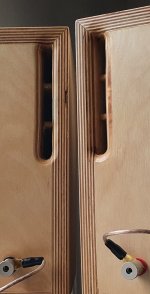
Bass reflex 8l, 45Hz. BR tunnel made of a piece of HDF glued on slats.
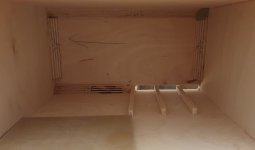
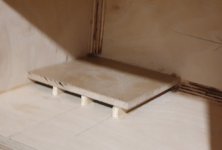
Crossovers assembled on a plywood scrap, attached with screws on an anti-vibration pad to the rear panel (installed through the woofer mounting hole).

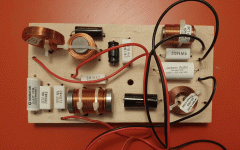
Crossover schematic and the characteristics, rating 6.78/8.81(EQ9) 6.133/7.57(EQ10)
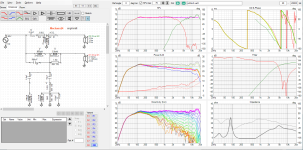
THD measurements: ~1.4% peak at 2kHz (87dB/1m)
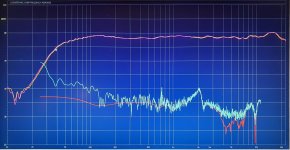
The first design was a Mechano (no number) with a 13cm Satori driver and a regular Seas dome. To get closer to the assumed goal, the crossover frequency had to be raised to 5kHz. The conclusion I took from this design was that to achieve the goal at lower crossover frequencies, the dome must be equipped with a WG or a horn or something that increases its directivity, or the midwoofer must have a smaller diameter (which reduces directivity). The next attempts were as follows:
-Mechano22 dome integrated with WG fp=3.6kHz (midwoofer 13cm)
-Mechano23 dome integrated with horn fp=3.4kHz (midwoofer 15cm)
-a design with a paper cone tweeter (not "promoted" to Mechano series) fp=4kHz (midwoofer 12cm)
-Mechano323 (3way) AMT fp=4.4kHz (mid 10cm)
Here is another design in the series, Mechano24, using ScanSpeak D2608/913000 driver, i.e. a dome with a profiled front. fp came out as 3.7kHz.
The midwoofer is 12W4524G00.

Enclosure dimensions: HxWxD: 290x174x263mm, polyester fiber filling.
18mm birch plywood, front panel glued "on top".

Rear panel flushed into the enclosure.

Bass reflex 8l, 45Hz. BR tunnel made of a piece of HDF glued on slats.


Crossovers assembled on a plywood scrap, attached with screws on an anti-vibration pad to the rear panel (installed through the woofer mounting hole).


Crossover schematic and the characteristics, rating 6.78/8.81(EQ9) 6.133/7.57(EQ10)

THD measurements: ~1.4% peak at 2kHz (87dB/1m)

Attachments
Brilliant job XMechanik  💪
💪
Studding different designs and listening to some of these I have com to the conclusion that what "we" want is not necessarily constant directivity, but a raising directivity slowly raising to DI around 10 at 20kHz. This will give a steady sloping frequency response falling ca 5 db at 20 kHz, of course somewhat depending on the actual room and the absorption over frequency. Direct frequency response should be flat from ca 2-500 Hz and up. And the In room Baas should be up at least 5 db from ca 100 Hz and down.
I think this is what you are also somewhat accomplishing.
My question is:
It seems you are really, really good at getting almost same response from all of your 2 way constructions.
How much of a difference do you find in the overall sound?
If frequency response (including Dir) is king, then the sound would be very similar, and maybe not so dependent on the driver or especially the cost of the driver!
Can you confirm this?
One thing I have found that has a huge impact on the sound is the bass extension and the level (the +5 db in low bass caused by room gain), meaning that too little bass will make for an irritating and very forward sounding HT.
 💪
💪Studding different designs and listening to some of these I have com to the conclusion that what "we" want is not necessarily constant directivity, but a raising directivity slowly raising to DI around 10 at 20kHz. This will give a steady sloping frequency response falling ca 5 db at 20 kHz, of course somewhat depending on the actual room and the absorption over frequency. Direct frequency response should be flat from ca 2-500 Hz and up. And the In room Baas should be up at least 5 db from ca 100 Hz and down.
I think this is what you are also somewhat accomplishing.
My question is:
It seems you are really, really good at getting almost same response from all of your 2 way constructions.
How much of a difference do you find in the overall sound?
If frequency response (including Dir) is king, then the sound would be very similar, and maybe not so dependent on the driver or especially the cost of the driver!
Can you confirm this?
One thing I have found that has a huge impact on the sound is the bass extension and the level (the +5 db in low bass caused by room gain), meaning that too little bass will make for an irritating and very forward sounding HT.
Thank you. Actually I don't think they look nice, in fact they look ugly to me! Maybe that's because I don't like asymmetrical driver placement. I tried this with my previous (3-way) design, noticed some pros and decided to try it also with Mechano24 2-way design. When I finished cutting holes I realized that I should have left at least midwoofer on the center but it was too late.Nice job overall. Engineering looks nice, construction looks nice, aesthetics look nice... Nice!
On the other hand they sound pretty good. The 2kHz THD peak is not noticeable at least with the spl levels I'm using. Bass extension is impressive for a 12cm driver (f6=43Hz if I did all the merging correctly) although seem a bit shy in the level domain. At first I was tempted to try some EQ, but after listening for a while I concluded that everything was fine and stayed with the Source Direct setting. The picture is clear, crisp and analytical.
A cool moment of DIYaudio hobby: browsing own well-known CDs shelf and still discovering something new!
The following chart shows comparison of DI for the tweeter, woofer and the resultant. Crossover frequency marked with the blue marker (ignore the 2kHz marker). Below 3kHz the DI is approximately woofer's DI, but in the 3-6kHz region, DI is a resultant of both drivers.Very nice indeed. Looking at the D.I., am I correct in assuming with such a high x/o frequency it is basically woofer off axis behaviour south of 5kHz that determines the relatively flat D.I.? Or is this assumption wrong?
BTW, there is a DI flaw in the 6kHz region but it's not very problematic. As a result it makes small local spl dip and fraction-db rise on PR. The rest of the characteristics look unaffected (In-room response, ER, Listening widow)
I can confirm that all these designs have a similar sound profile. Although they differ in details. For example, the last design, Mechano24, seems to me a bit more bright and analytical, and this is reflected in the characteristics: the bass does not go even 1dB above the mid-range tones before it starts sloping, and the dispersion of high tones is a little wider. But overall, the sound of these projects has a lot in common.It seems you are really, really good at getting almost same response from all of your 2 way constructions.
How much of a difference do you find in the overall sound?
Amir has carried out a thorough review of the Mechano23 speaker - and concluded that this is an excellent design:
https://www.audiosciencereview.com/...chano23-open-source-diy-speaker-review.54066/
XMechanik has every reason to be very proud of his design efforts!
https://www.audiosciencereview.com/...chano23-open-source-diy-speaker-review.54066/
XMechanik has every reason to be very proud of his design efforts!
These look amazing, exactly what I've been looking for for near-field monitors.
Can you confirm which is the latest crossover schematic? I'll be driving it from Leach amps, so I'm pretty relaxed about "difficult" loads
cheers
Can you confirm which is the latest crossover schematic? I'll be driving it from Leach amps, so I'm pretty relaxed about "difficult" loads
cheers
There are several different speaker designs in this thread. See the leading post (#1). Each of these designs I consider as latest and final.Can you confirm which is the latest crossover schematic? I
- Home
- Loudspeakers
- Multi-Way
- "Mechano22" - a small 2-way speakers with linear on-axis and power response characteristics



